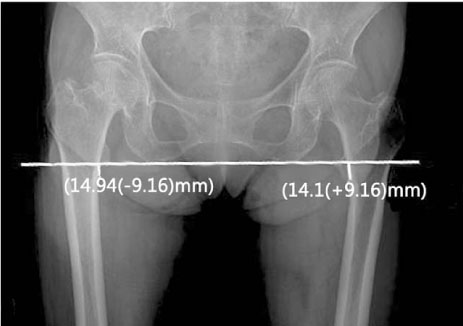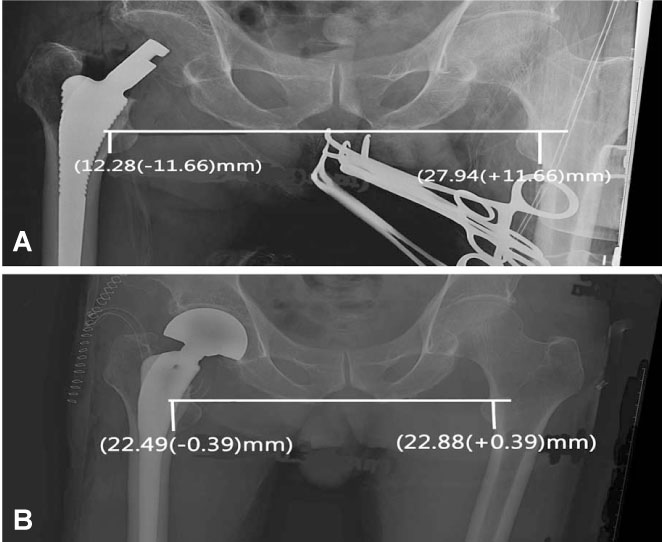J Korean Hip Soc.
2011 Dec;23(4):262-267. 10.5371/jkhs.2011.23.4.262.
Useful Method for Minimizing Leg Length Discrepancies in Hip Arthroplasty: Use of an Intraoperative X-ray
- Affiliations
-
- 1Department of Orthopedic Surgery, Hanil General Hospital, Seoul, Korea. pooljang105@hanmail.net
- KMID: 1452633
- DOI: http://doi.org/10.5371/jkhs.2011.23.4.262
Abstract
- PURPOSE
There are numerous opinions about the methods and usefulness of minimizing leg length discrepancies after hip arthroplasty. In this study, we tried to evaluate the usefulness of an intraoperative x-ray in addition to preoperative templating for minimizing leg length discrepancy.
MATERIALS AND METHODS
We reviewed pre- and post-operative pelvis AP x-rays of 46 patients who underwent hip arthroplasty due to a traumatic femoral neck fracture or intertrochanteric fracture between May 2008 and February 2009. A leg length discrepancy is the difference in vertical distance between a horizontal line drawn along the bottom of the ischial tuberosities and the most inferior points of the lesser trochanter. It was measured in a pelvis AP x-ray. In each case, pre-operative templating was performed and an intraoperative pelvis AP x-ray was taken again to assess the accuracy of preoperative planning. Implant positions were readjusted when necessary.
RESULTS
The mean post-operative leg-length discrepancy was 0.3 mm (SD, 3.1 mm). The range was from -5.8 mm to +5.9 mm.
CONCLUSION
Combining preoperative templating and intraoperative x-rays is a useful method of minimizing leg length discrepancy during hip arthroplasty.
Keyword
Figure
Reference
-
1. White TO, Dougall TW. Arthroplasty of the hip. Leg length is not important. J Bone Joint Surg Br. 2002. 84:335–338.2. Friberg O. Clinical symptoms and biomechanics of lumbar spine and hip joint in leg length inequality. Spine. 1983. 8:643–651.
Article3. Bose WJ. Accurate limb-length equalization during total hip arthroplasty. Orthopedics. 2000. 23:433–436.4. Woolson ST, Hartford JM, Sawyer A. Results of a method of leg-length equalization for patients undergoing primary total hip replacement. J Arthroplasty. 1999. 14:159–164.
Article5. Turula KB, Friberg O, Lindholm TS, Tallroth K, Vankka E. Leg length inequality after total hip arthroplasty. Clin Orthop Relat Res. 1986. 202:163–168.
Article6. Edeen J, Sharkey PF, Alexander AH. Clinical significance of leg-length inequality after total hip arthroplasty. Am J Orthop. 1995. 24:347–351.7. Ranawat CS, Rodriguez JA. Functional leg-length inequality following total hip arthroplasty. J Arthroplasty. 1997. 12:359–364.
Article8. Hofmann AA, Skrzynski MC. Leg-length inequality and nerve palsy in total hip arthroplasty: a lawyer awaits! Orthopedics. 2000. 23:943–944.
Article9. Goodman SB, Huene DS, Imrie S. Preoperative templating for the equalization of leg lengths in total hip arthroplasty. Contemp Orthop. 1992. 24:703–710.10. Woolson ST, Hartford JM, Sawyer A. Results of a method of leg-length equalization for patients undergoing primary total hip replacement. J Arthroplasty. 1999. 14:159–164.
Article11. Takigami I, Itokazu M, Itoh Y, Matsumoto K, Yamamoto T, Shimizu K. Limb-length measurement in total hip arthroplasty using a calipers dual pin retractor. Bull NYU Hosp Jt Dis. 2008. 66:107–110.12. McGee HM, Scott JH. A simple method of obtaining equal leg length in total hip arthroplasty. Clin Orthop Relat Res. 1985. 194:269–270.
Article13. Woolson ST, Harris WH. A method of intraoperative limb length measurement in total hip arthroplasty. Clin Orthop Relat Res. 1985. 194:207–210.
Article14. Ranawat CS, Rao RR, Rodriquez JA, Bhende HS. Correction of limb-length inequality during total hip arthroplasty. J Arthroplasty. 2001. 16:715–720.
Article15. Hofmann AA, Bolognesi M, Lahav A, Kurtin S. Minimizing leg-length inequality in total hip arthroplasty: use of preoperative templating and an intraoperative x-ray. Am J Orthop. 2008. 37:18–23.16. Canale ST. Campbell's Operative Orthopedics. 2008. 11th ed. New York: Mosby;338–342.17. Seo GT. Leg length discrepancy in total hip arthroplasty. J Korean Hip Soc. 2002. 14:308–311.18. Park WR, Moon KP, Suh KT. Leg length discrepancy after total hip arthroplasty. J Korean Hip Soc. 2010. 22:20–26.
Article19. Yoon HK, Chung JH, Han SC, Kim BK. The relationship between limb-length discrepancy on function, dislocation, pain and acetabular wear after bipolar hemiarthroplasty for femoral neck fracture. J Korean Hip Soc. 2009. 21:327–333.
Article
- Full Text Links
- Actions
-
Cited
- CITED
-
- Close
- Share
- Similar articles
-
- Fixing Leg Length Discrepancies after Total Hip Arthroplasty
- Leg Length Discrepancy after Total Hip Arthroplasty
- Functional Leg Length Inequality Following THA
- The Effect of Intraoperative Radiographs on Component Position and Leg Length during Routine Posterior Approach Total Hip Arthroplasty
- Total Hip Arthroplasty with F2L Multineck Cementless Femoral Stem




